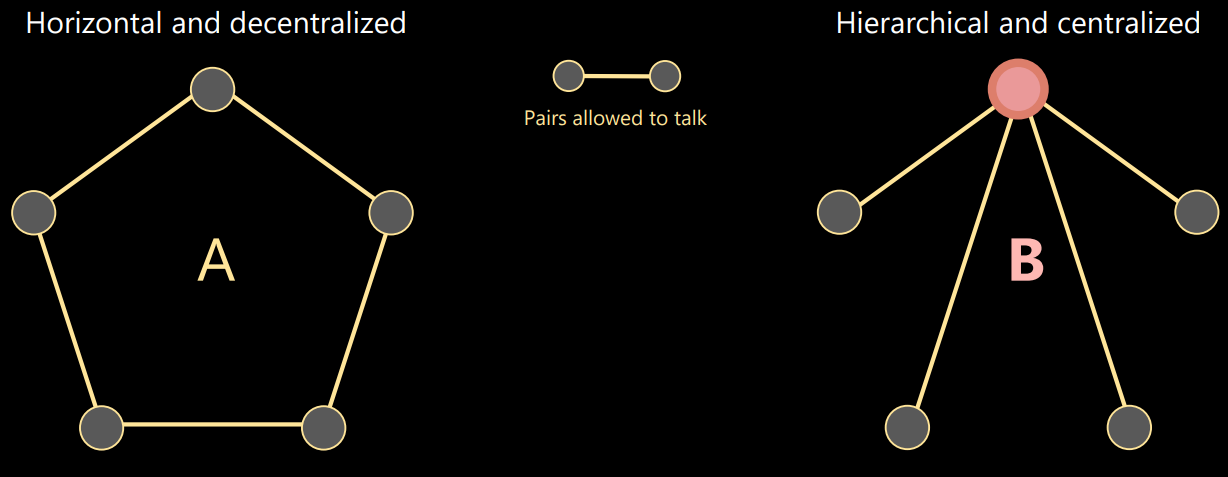Topic 3 Collective Intelligence (Part I)
3.1 Majority Rule and Condorcet’s Theorem
Condorcet was a philosopher and a mathematician who lived during France’s age of enlightenment. He was known for his theorem about the majority rule.
His theorem states that whenever a group of people make decisions that follow the majority rule:
- The probability of selecting the right decision is always greater than 50%
- The more people there are in the group, the likelier it is that the group picks the right choice
However, the theorem also assumes the following:
- There are only two possible selections to choose from
- The probability that somebody will make a right choice is greater than 50%
- Every voter will make their own decisions
Because of this, Condorcet argued that democracy is better than dictatorship as a collective decision making system.
3.2 Group Structure

Figure 3.1: Illustration of a Horizontal and a Hierarchical Group Structure
Each line between two circles (i.e., members) illustrates the fact that the two members in question are allowed to talk to one another.
Nonetheless, a horizontal structure where everybody is allowed to talk to one another is necessary for collective intelligence.
3.3 Group Diversity and Independent Thinking

Figure 3.2: Example of Diversity Using Adaptation
The above example illustrates why it’s always important to have diversity within a group. There’s no knowing what’s going to happen in the future.
However, it’s often difficult to maintain diversity in group settings due to the following reasons:
Social Conformity
People tend to mirror the beliefs, the attitudes, and the behaviors of those around them. Asch’s social conformity experiments showed this in 1951.
Peer Pressure
If a person is around a group of individuals with similar behavior, they may behave like the group’s people over time.
3.3.1 Sequential Decision Making
Sequential decision making is a kind of decision making whereby people can see what people before have done. The order in which a person makes decisions doesn’t really matter, but it’s the visibility that matters.

Figure 3.3: Simultaneous Decision Making
The above example of voting isn’t so much an example of sequential decision making, but rather, simultaneous decision making.
3.4 Herding Behavior
Herding behavior is the phenomenon whereby people tend to follow the crowd’s decisions instead of using their own information and their own decisions to do things.
When somebody herds, they usually believe one, if not both of the two things:
- Others must know something that they don’t.
- Others assume that what others are doing isn’t completely false.
3.4.1 Information Cascade

Figure 3.4: Example of an Information Cascade
The more people join a crowd, the more somebody else’s decisions become bigger and more dominant. Because of this, other people tend to make the same decision as others - in the above example, the more people there are in a restaurant, the more others will want to head to the restaurants that others are dining in.
This behavior is called an information cascade, but it’s important to know three things:
- Information cascades can lead to bad outcomes
- Cascades can be based on minimal information
- Cascades are fragile
That said, following the crowd isn’t such a bad thing to do, especially when you have little to no information.
3.5 Social Connections
There are two kinds of connections mentioned in this week:
3.5.1 Homophily
Homophily is a kind of connection whereby people who interact with one another have something in common. This results in something called a social cluster.
Figure 3.5: Example of a Social Cluster
There are also two kinds of social clusters:
Structurally Balanced
This is a kind of social cluster where there are an even amount of people who hate one another (i.e., the pink lines in the above graphic).
Structurally Unstable
This is a kind of social cluster that’s the oppostie of a structurally balanced cluster - there’s an uneven amount of negative relationships and because of this, there’s tension and conflict within the social cluster.
Because of this, we know that people will generally learn and listen from others who share their own views. However, this means that these same people also won’t be exposed to diverse opinions and hence, they’ll make poorer decisions.
Figure 3.6: Illustration of Cross-Cutting and Like-Minded Exposures
For this reason, we always encourage people to be more diverse (i.e., cross-cutting exposure).